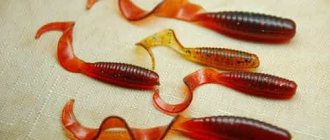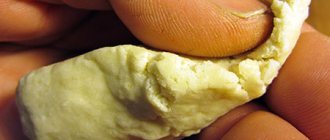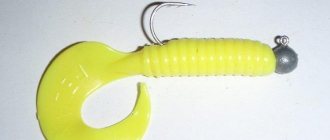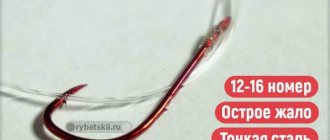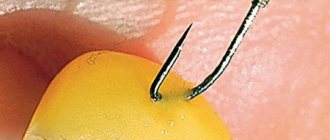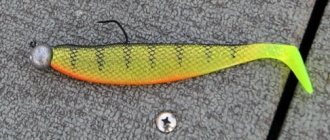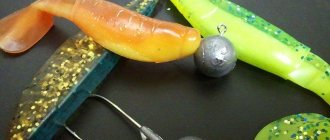Silicone has already become quite firmly entrenched in fishing thanks to its qualities of realistically conveying the movements of living creatures, which are food items for most fish inhabiting our water bodies. The variety of shapes, colors and scents of the attractant make baits made from this material suitable for many fishing conditions. In spinning fishing, the use of this type of bait has formed a separate branch of hunting, with its own equipment methodology and bait supply technique.
In addition to equipping artificial fish with weights in the form of jig heads and cheburashkas, an effective selection of a hook is also required, which, given certain structural parameters of the reservoir, will help make high-quality retrieves and more reliably realize predator bites. One of these possibilities is the installation of silicone baits on a double.
The method of this installation involves the separate use of a double with the subsequent installation of a load into the fastening ring of the accessory. But in order to properly rig the fisherman, he will need some knowledge and skills that will allow him to quickly and accurately assemble the rig in the field. We will discuss the features of installing silicone baits on double-type hooks in the course of our article.
Advantages and disadvantages of doubles
Equipping a vibrotail with a double has both its tangible advantages and a number of serious disadvantages that affect the comfort and effectiveness of fishing. The advantages include the high efficiency of catching a trophy. After all, an increased number of hooks allows you to increase the chances of successfully hooking a fish, and the fishing process is much more confident and reliable. The method of separately securing the load gives more freedom in the movement of the nozzle, without restricting the naturalness and believability of the artificial fish, and these are additional factors to tempt the predator to attack. On double hooks, the silicone holds much more securely than on single types of hooks, and during fishing, baits are lost very rarely, either due to unrealized bites or minor hooks.
Important! The disadvantages include the high degree of hookiness of the bait. Fishing in reservoirs with dense vegetation, snags and within the boundaries of trees that have fallen into the water is practically reduced to zero due to the impossibility of fishing.
Doppelgangers embedded in snags or underwater thickets are in most cases doomed to be lost. Also a negative factor is the influence of silicone itself on the material of the hooks, which during long-term storage causes serious corrosion of the metal and disables the hooks.
Important! Therefore, after the fishing season, the doubles must be removed from the bait.
This creates additional inconvenience, and subsequent installation will be of lower quality than the initial one.
Methods for attaching silicone baits
Nowadays, a spinning fisherman does not need any gear, bait, or accessories for fishing. In big cities you can buy almost everything by visiting a large fishing store.
Specific requirements can be met through online shopping, often resulting in significant savings. But having bought an armful of spinning rods and a mountain of baits, an angler will not become an experienced spinning player.
note
You still need to master fishing methods, and for this you need to learn how to use bait correctly, including mastering how to mount these baits, if necessary, and fishing with silicone baits just involves the use of several basic types of fishing, for which mounting the bait is of key importance .
There are several main types of installation of silicone baits. They are determined by the fishing method that the spinning angler chooses, the conditions of the upcoming fishing and, to some extent, the object that the angler is aiming to catch.
Classical
Mounting a silicone bait on a jig head is considered classic. A jig head is a lead weight that can have a different shape, with a single hook sticking out.
The advantage of the jig head is the ease of installation of the silicone bait: you just need to put it on the hook.
The disadvantages of the jig head are its unsatisfactory flight qualities (it can somersault in flight when casting) and the fact that at the base of the hook there is a lead “tooth” or other device designed to prevent the bait from sliding off the hook.
To do this, the “tooth” is cut off, then one of the hooks of the tee is stuck into the “back” part of the body of the bait, and the eye of the tee is put on the ring of the jig head.
Thus, after the jig head is fastened with a clasp, the tee becomes an additional element of the equipment, which contributes to better bites, and the silicone bait is securely fixed, without any damage.
This type of installation is especially effective when catching pike perch, which, as many anglers know, often prefers to hit the “head” of the bait. Of course, such equipment is used in places where there are no hooks.
Hinged mounting
Hinged mounting has recently become increasingly popular, as it provides the spinner with ample fishing opportunities.
The hinged mounting consists of a lead (sometimes brass or tungsten) weight equipped with two rings or a collapsible design.
Due to his resemblance to the famous cartoon character, he is often called “Cheburashka”. Hinged mounting has the following advantages:
- good aerodynamic characteristics;
- possibility of equipping with a single, double or triple hook;
- giving the bait additional play due to its movements left and right during retrieving;
- Possibility of making non-snacking installation.
The shape of the “Cheburashka” can be different: its choice is determined by the specific fishing conditions.
Almost always, an offset hook is used for fishing with a single hook.
If there are no obstacles in the form of snags, aquatic vegetation and stones at the fishing site, you can fish with an open hook.
The silicone bait is simply put on the offset machine in the same way as on the hook of a jig head. In order to prevent the bait from slipping, it is fixed with a special silicone stopper.
Important
In blind spots, the hook point must be closed to resist various hooks. For this purpose, non-meshing installation is used. It is carried out as follows:
- The tip of the hook is used to pierce the head of the bait and bring it to the step on the shank of the hook.
- Fix the front part of the bait by putting a silicone stopper on the fore-end.
- Unfold the bait in the required manner and pierce the back of the bait so that the hook tip is either recessed into the body of the bait, or is brought out, but is located parallel to the body of the bait, barely protruding beyond its limits.
Important! When putting a silicone bait on an offset machine with a non-clinging installation method, you should pierce the head part, orienting the bait not the way it should be in the mounted state, but vice versa. Then, after turning over on the step, it will take the correct position.
It takes a little experience to learn how to make such an installation without errors.
A very convenient device for making non-snacking installations are special corkscrew springs. One end of the spring is screwed into the front of the bait, the other is attached to the eye of the hook. Not only is this mount more reliable than simply fixing the “head” of the bait on the offset step, it also does not injure the bait at all.
In order to give the bait a more natural position on the offset, they use not ordinary straight hooks, but special ones with a wide bend (wide gap).
On a double hook
The silicone bait holds well on a double hook, is almost not injured during installation, the equipment flies far when casting, and the percentage of realized bites is much higher than when fishing with a single hook. Naturally, you should fish with a double hook if there are no hooks. Place the bait on the double as follows:
- The puncture site is determined by placing a double on the bait so that the eye of the hook comes out of the “head” of the twister or vibrotail.
- Slightly move the double hooks apart.
- Pierce the bait from the side and pull one of the hooks all the way through.
- Align the double relative to the body of the bait and push the fore-end forward until the eye appears from the head part.
Mounting a silicone bait on a double is used when fishing with a jig-spinning rod.
Healthy! Lures made from “edible” rubber have low strength. When casting, retrieving and biting, the bait begins to break, as it were, at the point where the double hooks exit.
We suggest you familiarize yourself with: Vibrating tails for pike fishing
In this case, you should cut off a small piece from the head of the bait and attach the double on a new one.
This operation can be carried out repeatedly until the bait loses its functionality.
On a treble hook
Mounting a silicone bait on a treble hook is a little more difficult. For installation you will need a short tube with a diameter of no more than 5 mm (for medium-sized baits). With its help, a hole is made in the side of the bait. First mark the place for the hole by attaching a tee so that the eye of the tee sticks out from the “head” of the bait.
One of the hooks is pulled into the resulting hole, which should protrude from one side. Another hook is pierced from the inside of the back of the bait, the third hook remains sticking out from the other side of the bait.
The eye of the tee is attached to the ring on the jig head or to the “ear” of the “Cheburashka”. The diameter of the hole is determined based on the size of the tee. A small hole will not allow the tee to be positioned symmetrically.
A hole that is too large will lead to play in the tee, which will worsen the performance of the bait.
You can do it differently. A piece of thin wire is passed through the body of the bait so that it comes out at the beginning of the tail, and a swivel with a tee is attached to it.
When fishing with large-sized bait, it is often necessary to equip it with several hooks, since the predator is sometimes not detected. You can use the following two methods:
- An additional tee is hooked onto a regular or offset hook.
- A small tee is tied to a piece of thin wire, which is stuck into the back of the bait, and the other end of the wire is attached to the eye of the jig head.
Let's look at which fishing methods and which types of rigs are used.
Texas rig
Texas equipment has almost 100% passability through obstacles and is used for fishing in snags, stones, and grass thickets. The Texas rig is a combination of a bullet-shaped sinker with a funnel-shaped recess in the back and an offset hook with a bait attached to it in a non-snagging version.
The offset machine's eye is hidden in the recess of the load, so the equipment does not have any protruding parts, due to which its unique properties are achieved.
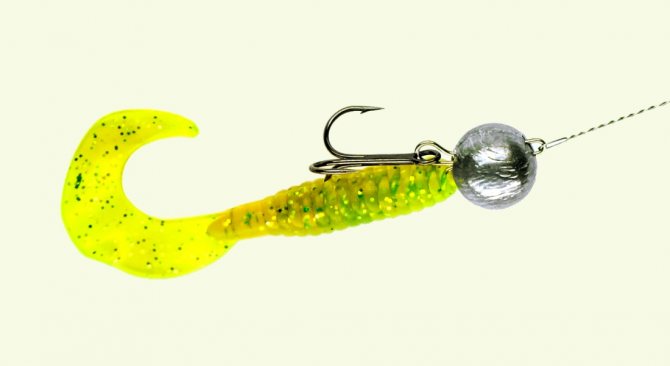
The Carolina rig consists of a sinker, which also has a bullet or olive shape; beads that prevent the knot from breaking and create sound vibrations; a swivel and a leash attached to it with a hook on which a silicone bait is attached. You can fish with a Carolina rig both in areas with a clean bottom and in “dead” places. In the first case, the tip of the hook is left open, in the second, a non-snagging installation of the bait on an offset hook is used.
Drop shot
When fishing with a drop-shot rig in places without hooks, they often use not an offset hook, but a regular hook. In snags and grass you can’t do without an offset tool. A hook with a bait, set in a non-swimming version, is tied with a special knot so that the hook is perpendicular to the main line or the line of the leash, and the tip points upward.
Retractable leash
When fishing with a retractable leash, you can use both hooks with an open tip and a non-snagging installation - all depending on the fishing conditions.
Wacky equipment
The Wacky rig as a type of installation and fishing method came to us from North America, like other methods of fishing with silicone baits.
The main catch of American fishermen was bass, but in our country, with the help of a weki rig, you can catch various predatory and semi-predatory fish.
The equipment has proven its effectiveness when catching passive predators or in pressed-in reservoirs.
However, among domestic fishermen, few are familiar with veki, not because its installation or animation presents any difficulties, but because of their commitment to traditional fishing methods. The weki rig is used when fishing for pike in grass windows, perch among stones and in some other situations.
Interesting! There is not a single spinning bait or fishing method invented exclusively for catching largemouth bass that domestic fishermen have not adopted and adapted to fish living in Russian waters. This fact testifies to the significant creative potential of our people.
How to put a vibrating tail on a double
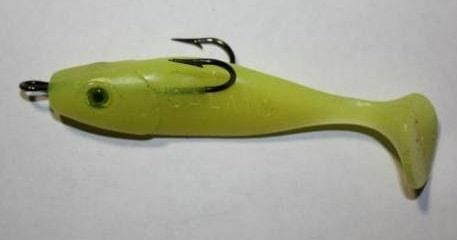
Installation is carried out using two main methods, one of which requires additional equipment in the form of a thin and durable 2–3 mm rod. The method using a rod involves the initial puncture of a hole in the body of the silicone and the subsequent insertion of the forend of the hook into this through puncture. The main point here is the selection of a rod with a diameter that is an order of magnitude smaller than the thickness of the accessory forend. Otherwise, the nozzle will dangle randomly on the hook without being firmly fixed.
You can put a vibrating tail on a double using the second method without additional equipment by piercing the body of the fish across the back with a through hole with one of the parts of the hook and spreading the double apart, pushing the fastening ring into the mouth area of the bait. Using the example of different types of nozzles, we will consider the main features of installation.
Features of installing vibrating tails on a double
To properly equip a vibrotail with a double, you must initially select a hook with a shank length comparable to the length of the bait’s body before it begins to narrow to the tail. A fish strung on the fore-end should not lose the mobility of its working element, that is, the tail. Having pierced the body of the silicone using one of the methods described above, the fastening ring of the accessory is released in the center of the muzzle of the bait, and the tip of the hooks is placed as close as possible to the back of the bait, practically placing the tip on the body of the bait.
Important! The stings of the hooks on vibrotails are visually located not in the center of the fish, but closer to its rear.
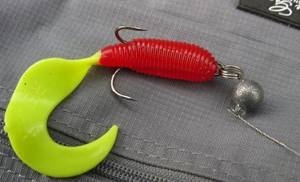
Properly installed silicone should sit firmly on the rod, without the possibility of scrolling or sliding, and also symmetrically with respect to its longitudinal axis. The asymmetry of the location of the nozzle will negatively affect the quality of the wiring performed, leading to the silicone falling to one side during pauses.
Single hook rig
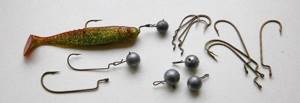
Almost always, an offset hook . If there are no obstacles in the form of snags, aquatic vegetation and stones at the fishing site, you can fish with an open hook. The silicone bait is simply put on the offset machine in the same way as on the hook of a jig head. In order to prevent the bait from slipping, it is fixed with a special silicone stopper.
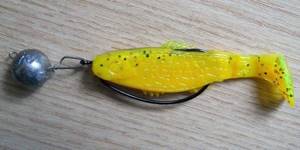
In blind spots, the hook point must be closed to resist various hooks. For this purpose, non-meshing installation . It is carried out as follows:
- The tip of the hook is used to pierce the head of the bait and bring it to the step on the shank of the hook.
- Fix the front part of the bait by putting a silicone stopper on the fore-end.
- Unfold the bait in the required manner and pierce the back of the bait so that the hook tip is either recessed into the body of the bait, or is brought out, but is located parallel to the body of the bait, barely protruding beyond its limits.
Expert opinion
Knipovich Nikolai Mikhailovich
Zoologist, hydrobiologist. I am interested in fishing at a professional level.
Important! When putting a silicone bait on an offset machine with a non-clinging installation method, you should pierce the head part, orienting the bait not the way it should be in the mounted state, but vice versa. Then, after turning over on the step, it will take the correct position.
It takes a little experience to learn how to make such an installation without errors.
A very convenient device for making non-snacking installations are special corkscrew springs . One end of the spring is screwed into the front of the bait, the other is attached to the eye of the hook. Not only is this mount more reliable than simply fixing the “head” of the bait on the offset step, it also does not injure the bait at all.
In order to give the bait a more natural position on the offset, they use not ordinary straight hooks, but special ones with a wide bend ( wide gap ).
Features of installing twisters on a double
Twisters differ in their type from vibrotails by a longer working body in the form of a tail with a spiral texture and by the body itself, a cylindrical and symmetrical shape. When choosing a hook suitable for the nozzle, you need to pay attention to the length of the fore-end, which is strictly kept at half the length of the cylindrical dense part of the twister. The point of the hooks is placed on the back of the twister, which is determined by the even, kinky hanging of the tail of the bait taken in the fingers, located in a horizontal position. The baits are placed tightly on the double, with the tip pressed to the body of the twister. The fastening ring, released in the front center of the end, should not protrude more than 1–2 mm beyond the dimensions of the nozzle. Otherwise, the bait will constantly move along the fore-end when moving, breaking the punctured hole and becoming unusable.
Hinged mounting
Hinged mounting of silicone baits has a number of advantages over rigid connections. Firstly, with this installation, the silicone bait receives a greater degree of freedom and its play becomes more realistic. Secondly, this design allows you to better penetrate the wind and send the tackle over longer distances. Hinged installations use single, double, triple and offset hooks.
The most common is installation using an eared sinker, called “Cheburashka” by fishermen. The sinker can be either collapsible or non-collapsible. The collapsible eared sinker allows you to quickly pull out the reinforcement to which the hook is attached and quickly change the nozzle. Unfortunately, with low-quality sinkers, this reinforcement may fall out during fishing.
A non-separable eared weight is connected to the hook through a winding ring; this installation is more reliable, which is why it is practiced when catching trophy fish. Also, the use of a winding ring gives the bait more freedom when playing, but worsens its passability.
A jig-rig works well in silty areas. This installation uses an elongated sinker that is connected to the main line and hook through a winding ring. As a result, when retrieving, the bait is not completely buried in the silt.
Common beginner mistake
Equipping a vibrating tail with a double with gross violations of installation technology leads to a significant deterioration in the quality of the wiring, reduces the likelihood of attracting a predator and disables the bait due to tears in the material and loss of rigid fixation on the hook shank.
Important! The most common mistake made by novice spinning fishermen is incorrectly selecting the length of the hook shank in relation to the artificial fish.
In this case, the bait loses significant movement abilities and loses its effectiveness. An inexperienced fisherman, having no idea about installing silicone, inserts only one part of the double into the fish’s body, thereby not balancing the movement of the bait, and when retrieving it, the bait falls to one side. A common mistake is an asymmetrical longitudinal puncture of the silicone body, which leads to the bait breaking off at the very first contact of the bait with a predator.
Mounting the bait at one edge
Such installation of silicone baits is used by fishermen during periods of weak bite, and can significantly increase the number of bites due to greater freedom when playing the bait, although the number of empty bites will also increase, since it will become more difficult to detect fish.

There are three ways to attach a silicone bait:
- Pass the hook along the axis of the bait and bring it out a little lower;
- Hook from below and move the sting along the axis of the bait;
- Hook from one side and pull out through the other;



